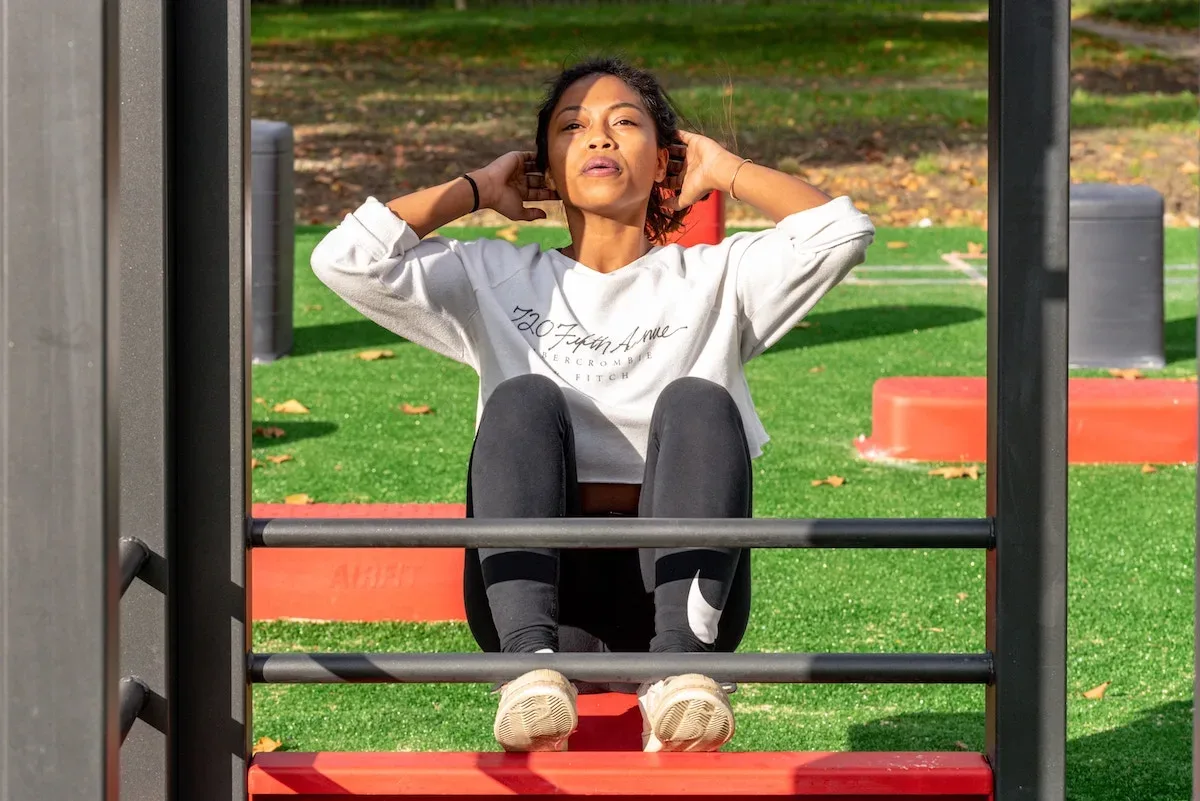If you’re looking for a great way to tone your midsection and build a stronger core, then look no further than abdominal crunches. This simple exercise is easy to do, requires no equipment, and can be done virtually anywhere. But before you dive in, it’s important to understand what this exercise is all about and how to do it properly.
The basic idea behind abdominal crunches is to strengthen the muscles in your midsection by contracting them repeatedly. This exercise primarily targets the rectus abdominis, which is the muscle responsible for the classic “six-pack” look. However, it also works other muscles in your core, including the obliques and transverse abdominis.
To perform an abdominal crunch, start by lying on your back with your knees bent and feet flat on the floor. Place your hands behind your head, but be careful not to pull on your neck. Next, contract your abs and lift your head and shoulders off the ground, keeping your feet and lower back firmly planted on the floor. Hold the contraction for a few seconds before slowly lowering yourself back down to the starting position.
It’s important to keep your movements slow and controlled throughout the exercise to avoid straining your neck or back. Start with a few repetitions and gradually work your way up to more as you get stronger. You can also try variations of the basic crunch, such as twisting your torso to work your obliques or lifting your legs to engage your lower abs.
The benefits of abdominal crunches are numerous. Not only do they help you build a stronger core, but they can also improve your posture, reduce back pain, and increase your overall athletic performance. Plus, they’re a great way to burn calories and tone your midsection, making them a must-try for anyone looking to improve their fitness level.
When incorporating abdominal crunches into your workout routine, be sure to complement them with other exercises that work your entire core, such as planks, leg lifts, and bicycle crunches. Remember to always listen to your body and avoid overexertion or strain.
Abdominal crunches are a simple yet effective exercise for anyone looking to build a stronger core and improve their overall fitness level. By mastering the proper technique and gradually increasing the intensity of your repetitions, you’ll be well on your way to a healthier, happier you. So why not give them a try and see what they can do for you?
Benefits of Core strength for Rugby players
Rugby is a physically demanding sport that requires strength, power, and endurance. One key area that rugby players need to focus on is their core strength. The core is the center of the body, and it includes the muscles of the abdomen, lower back, hips, and pelvis. Strong core muscles provide a solid foundation for movement and can improve overall performance on the field. In this article, we will explore the benefits of core strength for rugby players.
Improved stability and balance
A strong core provides a stable base for movement, allowing rugby players to maintain their balance and stability on the field. This can be particularly important when performing dynamic movements such as sidestepping, tackling, and jumping.
Increased power and explosiveness
Strong core muscles help to transfer power from the lower body to the upper body, allowing rugby players to generate more force with their movements. This can result in increased speed, power, and explosiveness on the field.
Injury prevention
A strong core can help to prevent injuries by providing support and stability for the spine and pelvis. Rugby players are particularly susceptible to lower back injuries due to the physical demands of the sport, and a strong core can help to reduce the risk of these injuries.
Improved posture
Good posture is essential for rugby players, as it allows them to maintain an optimal position for movement and reduce the risk of injury. A strong core can help to improve posture by supporting the spine and pelvis, allowing rugby players to maintain an upright position on the field.
Enhanced endurance
Rugby matches can last up to 80 minutes, and players need to maintain their physical performance throughout the entire game. A strong core can help to improve endurance by reducing fatigue and allowing players to maintain good form and technique for longer periods of time.
Core strength is essential for rugby players who want to perform at their best on the field. By incorporating core exercises into their training regimen, rugby players can improve their stability, power, explosiveness, posture, and endurance, while reducing the risk of injury. Whether you’re a seasoned rugby player or just starting out, focusing on your core strength can help to take your performance to the next level.
Performing Abdominal crunches
Abdominal crunches are a simple but effective exercise for strengthening the muscles in your midsection. Here’s a step-by-step guide on how to perform abdominal crunches:
- Lie on your back with your knees bent and feet flat on the floor. Place your hands behind your head, but be careful not to pull on your neck.
- Contract your abdominal muscles and lift your head and shoulders off the ground, keeping your feet and lower back firmly planted on the floor. Exhale as you lift up.
- Hold the contraction for a few seconds, making sure to keep your movements slow and controlled.
- Slowly lower yourself back down to the starting position, inhaling as you do so.
- Repeat the movement for the desired number of repetitions. It’s best to start with a few repetitions and gradually work your way up to more as you get stronger.
Tips for performing abdominal crunches
- Keep your movements slow and controlled to avoid straining your neck or back.
- Don’t pull on your neck with your hands – instead, use your abdominal muscles to lift your head and shoulders off the ground.
- Keep your feet and lower back firmly planted on the ground throughout the exercise.
- Exhale as you lift up, and inhale as you lower back down.
- Try variations of the basic crunch, such as twisting your torso to work your obliques or lifting your legs to engage your lower abs.
Incorporating abdominal crunches into your regular workout routine can help you build a stronger core, improve your posture, reduce back pain, and increase your overall athletic performance. Remember to always listen to your body and avoid overexertion or strain.
Risks of Abdominal crunches
While abdominal crunches are a generally safe and effective exercise for strengthening the muscles in your midsection, there are some potential risks that you should be aware of. Here are some of the risks associated with abdominal crunches:
- Neck and back strain: If you pull on your neck or use improper form, you may strain the muscles in your neck or back. It’s important to keep your movements slow and controlled and avoid pulling on your neck during the exercise.
- Spinal compression: Repeatedly flexing your spine during abdominal crunches can lead to spinal compression over time, which can increase your risk of developing back pain or injury. To avoid this, try to keep your movements slow and controlled and focus on engaging your core muscles rather than just crunching your spine.
- Herniated discs: If you already have a herniated disc in your spine, performing abdominal crunches may aggravate the condition and cause further injury. It’s important to speak with your healthcare provider before starting any new exercise program if you have a history of back pain or injury.
- Overuse injuries: Overdoing it with abdominal crunches or performing them too frequently can lead to overuse injuries such as strains or sprains. It’s important to listen to your body and avoid overexertion or strain.
- Limited benefits: While abdominal crunches can be effective for strengthening the muscles in your midsection, they only target a specific set of muscles and may not provide the same overall benefits as other exercises that work the entire core.
To minimize the risks associated with abdominal crunches, it’s important to use proper form, avoid overexertion, and listen to your body. You may also want to consider incorporating other exercises that work the entire core, such as planks, leg lifts, and bicycle crunches, into your workout routine to maximize the benefits and reduce the risk of injury.
Alternatives to Abdominal crunches
If you’re looking for alternatives to abdominal crunches, there are several exercises that can help you strengthen your core muscles and improve your overall fitness. Here are some options to consider:
- Plank: The plank is a great exercise for strengthening the entire core, including the muscles of the abdomen, lower back, and hips. To perform a plank, start in a push-up position with your forearms on the ground, elbows directly under your shoulders, and toes on the floor. Hold the position for as long as you can while keeping your core muscles engaged.
- Bicycle crunch: The bicycle crunch is a variation of the basic crunch that targets the oblique muscles on the sides of your abdomen. To perform a bicycle crunch, lie on your back with your hands behind your head and your knees bent. Lift your shoulders off the ground and twist your torso to bring your left elbow toward your right knee. Straighten your left leg and repeat on the other side, alternating sides for the desired number of repetitions.
- Russian twist: The Russian twist is another exercise that targets the oblique muscles. To perform a Russian twist, sit on the floor with your knees bent and your feet flat on the ground. Lean back slightly and lift your feet off the ground. Hold a weight or medicine ball with both hands and twist your torso to the left, then to the right, keeping your feet off the ground the entire time.
- Mountain climber: The mountain climber is a dynamic exercise that targets the entire core, as well as the muscles of the arms and legs. To perform a mountain climber, start in a push-up position with your hands on the ground and your feet on the floor. Bring one knee toward your chest, then switch legs, alternating legs for the desired number of repetitions.
- Side plank: The side plank is a variation of the plank that targets the oblique muscles on one side of your body. To perform a side plank, lie on your side with your forearm on the ground and your elbow directly under your shoulder. Lift your hips off the ground and hold the position for as long as you can while keeping your core muscles engaged. Repeat on the other side.
Incorporating these exercises into your workout routine can help you build a stronger core and improve your overall fitness. Remember to always use proper form and listen to your body to avoid injury.

